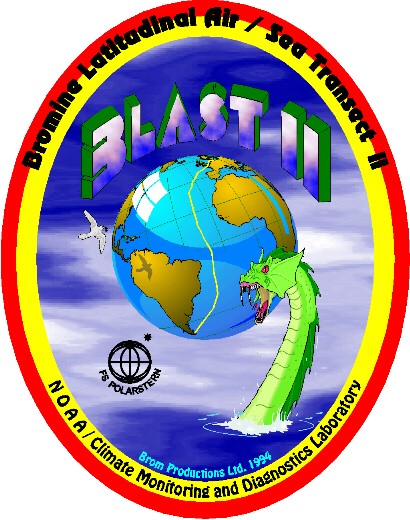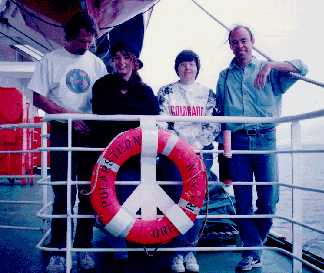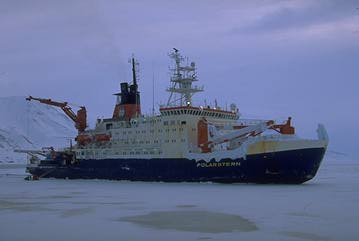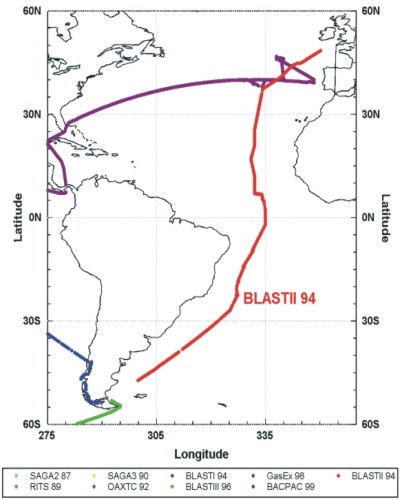BLAST II Homepage
This is the official mission logo. Click on the image
to download an encapsuled postscript file from our public ftp site, it's
called blast2.eps (a compressed version is also available).

Abstract
This cruise was a continuation of the BLAST 94 mission in order to verify
findings from the first cruise. In addition to all compounds that were
measured during BLAST 94, we added some other halogenated methanes. The
cruise led our team through the Atlantic ocean, covered an equally wide
latitudinal range as BLAST 94, similar oceanic regimes such as coastal
and coastally influenced waters, upwelling regions and open ocean gyres,
but slightly different seasons, fall in the northern hemisphere and spring
in the southern hemisphere. The entire cruise was almost 5 weeks long and
was conducted between 18 October, 1994 and 21 November, 1994. The data
for methyl bromide basically confirmed what we saw during BLAST 94 and
contributed valuable information to our database for methyl halides.
Methods and list of (the most important) measured compounds:
| Gas chromatograph / mass spectrometer combination: |
| HCFC-22 |
CHClF2 |
| CFC-12 |
CCl2F2 |
| Methyl chloride |
CH3Cl |
| CFC-114 |
C2Cl2F4 |
| Halon-1211 |
CBrClF2 |
| Methyl bromide |
CH3Br |
| CFC-11 |
CCl3F |
| Methyl iodide |
CH3I |
| Methyl chloroform |
CH3CCl3 |
| Carbon tetrachloride |
CCl4 |
| Dibromomethane |
CH2Br2 |
| Perchloroethylene (PCE) |
C2Cl4 |
| Bromoform |
CHBr3 |
| Gas chromatograph / electron capture detector
(deepwater): |
| Methyl bromide |
CH3Br |
| CFC-12 |
CCl2F2 |
| Methyl chloride |
CH3Cl |
| Nitrous Oxide |
N2O |
| Gas chromatograph / electron capture detector
(surface water): |
| CFC-12 |
CCl2F2 |
| CFC-11 |
CCl3F |
| CFC-113 |
CCl3CF3 |
| Methyl chloroform |
CH3CCl3 |
| Carbon tetrachloride |
CCl4 |
| Nitrous Oxide |
N2O |
| Sulfur Hexafluoride |
SF6 |
Cruise Participants:

From left to right: Jim, Laurie, Shari, and Jürgen, just arriving
in Punta Arenas, Chile.
The Platform:

The FS Polarstern operates out of Bremerhaven, Germany, and is
run by the Alfred Wegener Institut für Polarforschung mainly as a
research vessel and supply ship for the German Antarctica station Georg
von Neumayer. The ship is 105 m long and 25 m wide. It was put into
service in 1982 and is run by a 41 hand crew, with a capacity of up to
40 scientists. The ship is designed to break through ice of up to 4 m thickness
and is supplied with, amongst others, two helicopters, several heavy-duty
cranes, and space for 16 containers.
.
Cruise Track:

BLAST II is shown in red through the Atlantic Ocean, out of Bremerhaven,
Germany into Punta Arenas, Chile.
Contacts:
Publications
Data & Graphs
Data from this cruise can be downloaded from our public ftp site at
ftp.cmdl.noaa.gov,
subdir /hats/ocean/blast_ii.



